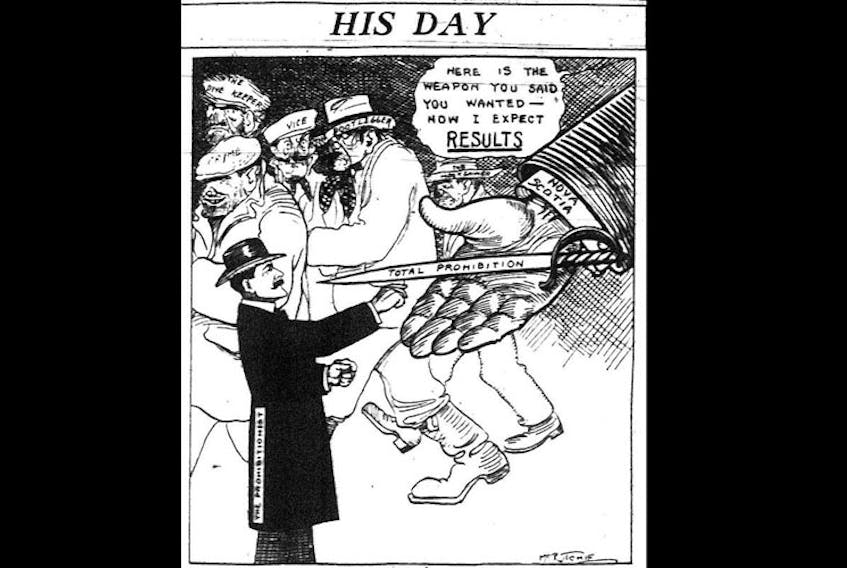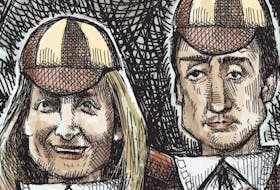What is the world going to look like on Wednesday when the sale of cannabis officially passes from the shifty-looking character in the school parking lot to a provincial government employee in a store as shiny and sleek as a boutique on the Halifax waterfront?
Well, there is a bit of a precedent.
In 1930 Nova Scotia went from officially prohibiting alcohol — you know, Prohibition — to legalizing it and handing control and marketing of it over to a provincial monopoly.
First a little background, thanks to some recent research from Heritage Trust of Nova Scotia.
READ MORE: Our full report on the legalization of cannabis
Gabrielle Caras has been looking into the long history of saloons, groggeries, blind-pigs and bootleggers in Halifax, a place where, in the last days of the 18th century, a visiting clergyman observed that the business of one half of Halifax was to sell rum and the other half to drink it.
Not a lot, then, had changed by 1883 when Caras discovered that the city’s directory listed more than 150 legal liquor sellers, which, in those days, meant retailers, wholesalers and hotels.
By then the city had a population of no more than 50,000 people. According to my Grade 11 math, that works out to one place to go and imbibe for every 333 Haligonians, whether men, women or children, which strikes me as a telling number.
As the years progressed the laws began to tighten up. In 1910 the only way someone could buy booze was for medicinal purposes, or to use as sacramental wine or to make some kind of confectionary.
The purveyors also faced tighter restrictions. Caras points out they had to have a door to the street and big windows though which, presumably, the inspectors could stick their inquiring heads.
The 1916-1917 Halifax business directory lists 38 people as liquor vendors.
But Prohibition came into force on June 30 of that year. The following year’s directory listed one liquor peddler, Kelley & Glassey Ltd., at 196-208 Hollis Street.
But commerce will find a way.
Sometime ago, in this space, I interviewed Jim Cuvelier, a centenarian who regaled me with tales of the bad old days when speakeasies and bootleggers riddled the city’s north end.
He was talking about the years before Aug. 17, 1930, the day Nova Scotia opened its first post-Prohibition liquor stores — when it again became possible for a person to buy booze without sneaking around like, well, what it was like buying weed later in the 20th century.
I’m finally getting to my point here.
It comes thanks to historian David Sutherland, who pointed me to the pages of one of the predecessors to this paper at a moment as historic in its way as the legalization of cannabis will be on Oct. 17.
The scene as the province’s first liquor stores opened was, in Sutherland’s words, “quite dramatic.”
He meant the lineups waiting for the stores to open, along with the ensuing rush of business from American tourists, “bar flies ... unkempt, unshaven and unwashed ... who hung about hopefully on the curb clinging to the faint hope of a free drink” and even, gasp, women.
By the look of it, those stores — the first ones to open according to Sutherland — were on Hollis, Buckingham and Gottingen streets in Halifax along with one in Dartmouth — were quite a contrast to the bootlegging establishments that lay deserted.
Crepe hung from on the door of 113 Market St., formerly headquarters of the notorious Dauphinee bootlegging gang.
At a Rocky Lake roadhouse, according to a story in the Halifax Mail Star, “all the more prominent bootleggers in Halifax assembled to hold a farewell celebration to the happy days of Prohibition which had meant so much to them.”
It sounded like a sentimental affair, complete with tearful renditions of The Last Rose of Summer as the bootleggers, “the majority of whom are romantic at heart,” celebrated late into the evening.
Some of them, according to friends, planned to leave the city and start restaurants or rooming houses in other parts of the province. Others, well who knows what their plans were.
Some of the headlines in the days that followed the end of Prohibition seem to have parallels in today’s legal cannabis-era: consumers griping that the hooch was too expensive and that there weren’t enough stores selling it; “hop beer merchants” — whoever they were — worried about whether they are allowed to operate or not under the new rules.
In the days after the new rules came into law there were reports of New England tourists pouring into Nova Scotia by steamer, drawn by access to legal booze.
The front pages of the paper carried stories about men getting arrested for being drunk in public, or possessing beer that didn’t have the official provincial government seal.
It sounded chaotic 88 years ago. I’m hoping things will be different on Wednesday.









